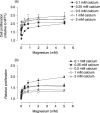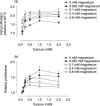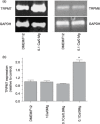Importance of melastatin-like transient receptor potential 7 and cations (magnesium, calcium) in human osteoblast-like cell proliferation
- PMID: 18021175
- PMCID: PMC6495302
- DOI: 10.1111/j.1365-2184.2007.00476.x
Importance of melastatin-like transient receptor potential 7 and cations (magnesium, calcium) in human osteoblast-like cell proliferation
Abstract
Bone tissue in the adult is continuously being remodelled, and overall bone mass is maintained constant by the balance between osteoclastic bone resorption and osteoblastic bone formation. Adequate osteoblastic proliferation is essential for both appropriate formation and for regulation of resorption, and thereby the maintenance of bone remodelling equilibrium.
Objectives: Here, we have investigated the roles of melastatin-like transient receptor potential 6 and 7 (TRPM6, TRPM7), which are calcium (Ca2+) and magnesium (Mg2+) conducting channels, during proliferation of human osteoblasts.
Results: Genetic expression of TRPM6 and TRPM7 was shown in human osteoblast-like MG-63, SaOS and U2-OS cells, and reduction of extracellular Mg2+ or Ca2+ led to a decrease of cell proliferation. Concomitant reduction of both ions further accentuated reduction of cell proliferation. Expression of TRPM7 channels was increased under conditions of reduced extracellular Mg2+ and Ca2+ levels whereas expression of TRPM6 was not modified, suggesting compensatory mechanisms afforded by TRPM7 in order to maintain intracellular ion homeostasis. Pre-incubation of cells in reduced extracellular Mg2+ conditions led to activation of Ca2+ and Mg2+ influx. Reduction of TRPM7 expression by specific siRNA prevented latter influx and inhibited cell proliferation.
Conclusions: Our results indicate that extracellular Mg2+ and Ca2+ deficiency reduces the proliferation of human osteoblastic cells. Expression and activity of TRPM7 is modulated by extracellular Mg2+ and Ca2+ availability, indicating that TRPM7 channels are involved in intracellular ion homeostasis and proliferation of osteoblasts.
Figures







References
-
- Aarts M, Iihara K, Wei WL, Xiong ZG, Arundine M, Cerwinski W, MacDonald JF, Tymianski M (2003) A key role for TRPM7 channels in anoxic neuronal death. Cell 115, 863–877. - PubMed
-
- Bergman RJ, Gazit D, Kahn AJ, Gruber H, McDougall S, Hahn TJ (1996) Age‐related changes in osteogenic stem cells in mice. J. Bone Miner. Res. 11, 568–577. - PubMed
-
- Berridge MJ, Lipp P, Bootman MD (2000) The versatility and universality of calcium signalling. Nat. Rev. Mol. Cell Biol. 1, 11–21. - PubMed
-
- Brockstedt H, Kassem M, Eriksen EF, Mosekilde L, Melsen F (1993) Age‐ and sex‐related changes in iliac cortical bone mass and remodeling. Bone 14, 681–691. - PubMed
Publication types
MeSH terms
Substances
LinkOut - more resources
Full Text Sources
Miscellaneous

